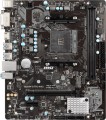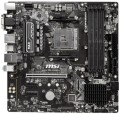Power phases
The number of processor power phases provided on the motherboard.
Very simplistically, phases can be described as electronic blocks of a special design, through which power is supplied to the processor. The task of such blocks is to optimize this power, in particular, to minimize power surges when the load on the processor changes. In general, the more phases, the lower the load on each of them, the more stable the power supply and the more durable the electronics of the board. And the more powerful the CPU and the more cores it has, the more phases it needs; this number increases even more if the processor is planned to be overclocked. For example, for a conventional quad-core chip, only four phases are often enough, and for an overclocked one, at least eight may be needed. It is because of this that powerful processors can have problems when used on inexpensive low-phase motherboards.
Detailed recommendations on choosing the number of phases for specific CPU series and models can be found in special sources (including the documentation for CPU itself). Here we note that with numerous phases on the motherboard (more than 8), some of them can be virtual. To do this, real electronic blocks are supplemented with doublers or even triplers, which, formally, increases the number of phases: for example, 12 claimed phases can represent 6 physical blocks with doublers. However, virtual phases are much inferior to real ones in terms of capabilities — in fact, t...hey are just additions that slightly improve the characteristics of real phases. So, let's say, in our example, it is more correct to speak not about twelve, but only about six (though improved) phases. These nuances must be specified when choosing a motherboard.
VRM heatsink
The design of the motherboard has a separate heatsink for VRM.
VRM is a voltage regulation module through which power from a computer power supply is supplied to the processor. This module steps down the standard power supply voltage (+5V or +12V) to a lower value required by the processor (usually just over 1V). At high loads, the voltage regulator can get very hot, and without a specialized cooling system, the matter can end with overheating and even burnout of parts. The VRM heatsink reduces the likelihood of such situations; it can be useful for any CPU, and highly desirable if the board is planned to be used with a powerful high-end processor (especially overclocked).
Size (HxW)
Motherboard dimensions in height and width. It is assumed that the traditional placement of motherboards is vertical, so in this case one of the dimensions is called not the length, but the height.
Motherboard sizes are largely determined by their form factors (see above), however, the size of a particular motherboard may differ slightly from the standard adopted for this form factor. In addition, it is usually easier to clarify the dimensions according to the characteristics of a particular motherboard than to look for or remember general information on the form factor. Therefore, size data can be given even for models that fully comply with the standard.
The third dimension — thickness — is considered less important for a number of reasons, so it is often omitted.
DDR4
The number of slots for DDR4 memory sticks provided in the motherboard.
DDR4 is a further (after the third version) development of the DDR standard, released in 2014. Improvements compared to DDR3 are traditional — an increase in operating speed and a decrease in power consumption; The volume of one module can be from 2 to 128 GB. It is this RAM standard that most modern motherboards are designed for; the number of slots for DDR4 is usually
2 or
4, less often —
6 or more.
Max. clock frequency
The maximum RAM clock speed supported by the motherboard. The actual clock frequency of the installed RAM modules should not exceed this indicator — otherwise, malfunctions are possible, and the capabilities of the “RAM” cannot be used to the fullest.
For modern PCs, a RAM frequency of
1500 – 2000 MHz or
less is considered very low,
2000 – 2500 MHz is modest,
2500 – 3000 MHz is average,
3000 – 3500 MHz is above average, and the most advanced boards can support frequencies of
3500 – 4000 MHz and even
more than 4000 MHz.
Max. memory
The maximum amount of RAM that can be installed on the motherboard.
When choosing according to this parameter, it is important to take into account the planned use of the PC and the real needs of the user. So, volumes
up to 32 GB inclusive are quite enough to solve any basic problems and run games comfortably, but without a significant reserve for an upgrade.
64 GB is the optimal option for many professional use cases, and for the most resource-intensive tasks like 3D rendering,
96 GB or even
128 GB of memory will not be a limit. The most “capacious” motherboards are compatible with volumes of
192 GB or
more - they are mainly top-end solutions for servers and HEDT (see “In the direction”).
You can choose this parameter with a reserve – taking into account a potential RAM upgrade, because installing additional RAM sticks is the simplest way to increase system performance. Taking this factor into account, many relatively simple motherboards support very significant amounts of RAM.
XMP
The ability of the motherboard to work with RAM modules that support
XMP (Extreme Memory Profiles) technology. This technology was developed by Intel; it is used in motherboards and RAM blocks and only works if both of these system components are XMP compliant. A similar technology from AMD is called AMP.
The main function of XMP is to facilitate system overclocking (“overclocking”): special overclocking profiles are “sewn” into the memory with this technology, and if desired, the user can only select one of these profiles without resorting to complex configuration procedures. This is not only easier, but also safer: every profile added to the bar is tested for stability.
1x PCI-E slots
Number of PCI-E (PCI-Express) 1x slots installed on the motherboard. There are
motherboards for 1 PCI-E 1x slot,
2 PCI-E 1x slots,
3 PCI-E 1x ports and even more.
The PCI Express bus is used to connect various expansion cards — network and sound cards, video adapters, TV tuners and even SSD drives. The number in the name indicates the number of PCI-E lines (data transfer channels) supported by this slot; the more lines, the higher the throughput. Accordingly, PCI-E 1x is the basic, slowest version of this interface. The data transfer rate for such slots depends on the PCI-E version (see "PCI Express Support"): in particular, it is slightly less than 1 GB / s for version 3.0 and slightly less than 2 GB / s for 4.0.
Separately, we note that the general rule for PCI-E is as follows: the board must be connected to a slot with the same or more lines. Thus, only single-lane boards will be guaranteed to be compatible with PCI-E 1x.
Steel PCI-E connectors
The presence of reinforced
steel PCI-E connectors on the "motherboard".
Such connectors are found mainly in gaming (see "In the direction") and other advanced varieties of motherboards, designed to use powerful graphics adapters. Steel slots are usually made PCI-E 16x, just designed for such video cards; in addition to the slot itself, its attachment to the board also has a reinforced design.
This feature offers two key advantages over traditional plastic connectors. Firstly, it allows you to install even large and heavy video cards as reliably as possible, without the risk of damaging the slot or board. Secondly, the metal connector plays the role of a protective screen and reduces the likelihood of interference; this is especially useful when using multiple video cards installed side by side.

